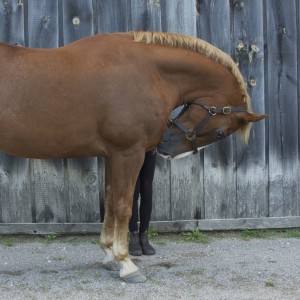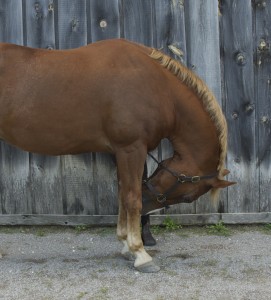Photo credit: Anna Shipside
Carrot stretches are an easy and effective way to develop the stabilizing muscles of the horse’s back. Recent studies have been able to show the significant effect of these exercises on the multifidus muscles – the small inter-vertebral muscles that help stabilize and protect the spine – when performed on a regular basis.
Back pain and injury can inhibit these muscles causing them to atrophy, leaving the back vulnerable. Often the long back muscles (longissimus and iliocostalis) will try to compensate, resulting in tension and muscle spasm along the back.
Carrot stretches bring the horse into positions beyond what their normal work under-saddle entails – positions where they not only have to bend through their spine, but where they must also stabilize, especially through the the vertebral joints, which activates the multifidus muscles.
Though safe for most horses, carrot stretches should not be done with horses with a history of severe musculoskeletal injury or neurological disease without veterinary approval to make sure they are at the appropriate stage of healing.
Carrot stretch guidelines:
- Perform the exercises on level, non-slip footing in an enclosed area, with the horse standing square and balanced.
- Begin gradually. Increase the degree of motion/stretch over a series of sessions.
- Perform 3-5 repetitions of each exercise, 4-5 days a week, or as regularly as possible.
- Always stand in a safe position relative to the horse and maintain enough space around you to be able to step back if necessary.
- Wear gloves to protect your fingers. A finger protector can also be made with a firm but pliable plastic lid, such as that from a coffee can, by cutting an X in the middle for the carrot to go through.
- Because the horse is not passive in these stretches and can control the degree of stretch, they can be performed before or after exercise
Instructions for performing carrot stretches:

Fig. 1 Chin to chest
Rounding exercises (Figures 1-3)
Your horses head and neck should remain straight and in alignment with the middle of the body through the exercise without twisting to one side, their ears remaining level with each other.
While this may take a bit of practice, try to encourage them to come straight down through the positioning of the carrot. You may want to try switching the sides that you stand on, performing half the repetitions from each side.

Fig. 2 – Chin to knees
Encourage your horse to hold each position for several seconds, followed by a moment to allow them to relax their muscles and return to neutral before the next attempt.
Over time you can begin to encourage your horse to bring their nose further between their legs.
Fig. 3 – Chin to fetlocks
Lateral Bending (Figure 4)
For the lateral stretch you can bring your horse’s nose to the level of their girth, further back toward their stifle, or even their hind fetlock. Again, begin gradually, only increasing the difficulty as your horse becomes more stable and flexible in the stretch.
The carrot should be held about 1-2 feet away from the side of your horse’s body, and never any higher than the level of their flank (if you hold it too high some horses will hollow, rather than round their back).
Try to keep your horse’s ears at the same level, encouraging them to truly bend through the length of their neck, rather than twisting around.
For more information on these exercises and others, Dr. Hilary Clayton and Narelle Stubbs have an excellent book, “Activate your Horse’s Core: Unmounted Exercises for Dynamic Mobility, Strength & Balance,” which provides a comprehensive step-by-step guide. It’s laminated, spiral bound and comes with a DVD — A great resource for any horse owner.
This post is based on material from an article I wrote, and worked together with Dr. Hilary Clayton on, for Canadian Horse Journal. “Understanding Equine Back Pain”, was published in the November 2012 issue of the magazine, and explores our current model for understanding how back pain works, and what we can do to try to prevent it.
Many thanks to Anna Shipside and (the very cute and handsome) Chevy for their help in taking these photos
Related Posts:
Conditioning your horse for success and soundness
Getting “in touch” with your horses body
How your horse’s muscles help keep him sound Pt. 1


